PHOENIX — A newly released report outlines major changes recommended for Lewis prison and the Arizona Department of Corrections after video surfaced in April of inmates streaming out of their cells and attacking two corrections officers.
A corrections officers union said the assault caught on camera revealed the ongoing security issues at the prison in Buckeye—including inmates tampering with locks so their cells could be opened from the inside.
Gov. Doug Ducey responded to the video by putting former Arizona Supreme Court Justices Rebecca Berch and Ruth McGregor in charge of an investigation into prison safety.
The justices’ report released Thursday outlines the cell door tampering problem that can be linked to at least 17 assaults at the prison resulting in serious injuries to inmates and corrections officers.
The report also criticizes the leadership of ADC Director Charles Ryan, who announced last week he would be retiring in September.
“We conclude that the Director, for too long, remained surprisingly uninformed about the poor functioning of the locks and scope and seriousness of the danger the inmate [tampering] issue that resulted at Lewis posed to inmates and officers. That is not acceptable.”
The ADC said in a statement Thursday that it will work to implement the report’s recommendations.
“Their report provides a thorough and fair assessment of the facts relating to locking system issues at the Lewis prison and the contributing operational challenges within the Department,” ADC said.
Here is a look at what the justices’ investigation found.
History of lock issues
According to the report, the prison’s lock problems didn’t begin recently; the first mention of inmates manipulating the locks was in 2003. The ADC’s website even has a video made at Lewis prison in 2006 showing how inmates can keep the doors from securing properly.
Lock problems were again noted at Lewis from 2010 to 2014, particularly with the slider doors, the report says. But the justices' investigation found the reports from that time were inconsistent as to the extent of the issue.
In 2017, the report says, there was general agreement that inmates leaving their cells without permission became a problem at the prison.
The report says the prevalence of gang activity in late 2017 and 2018 may have contributed to the increase in lock tampering as inmates left their cells to communicate with other members of their gang or reach members of competing gangs.
In reviewing video of inmates getting out of their cells, the investigation found inmates getting out of their cells had apparently become a mundane occurrence.
“The inmates evidence no concern that they are visible on video and they may be called to account for their actions. The presence of an officer does not seem to deter this behavior,” the report says.
The justices’ investigation found 50 to 70 percent of incidents where inmates left their cells were not reported. The report said corrections officers were often instructed not to report security incidents to make a supervisor or unit “look good.” There is also a lack of instant electronic communication that would provide a record of a security incident, the report noted.
Dispute over how to fix the problem
According to the report, there was disagreement between the supervisors and officers on whether the locks were actually broken.
Management initially said the doors did not need fixing or replacing, since any door can be manipulated by placing a small object in the door track to prevent the locks from fully engaging, according to the report. The prison leadership said the corrections officers needed to inspect the door frames more closely, the report says.
The officers, however, said the doors are getting old and have sufficient “give” in them to allow inmates to tamper with them, according to the report. They also said understaffing at the prison did not allow them enough time to inspect the door frame and shake the door for a few seconds each time an inmate returns to his cell.
RELATED: Report: AZ Department of Corrections paid over $40 million in overtime amid staffing crisis
The report says the many maintenance requests for lock repairs support the officers’ contention that some of the locks are just broken. It is also noted that the doors are now 20 years old and see a lot of use each day.
The problem worsens
Prison officials authorized the use of pins on cell doors to help alleviate the lock problems in November 2017. The pins were installed between January and June.
But this supposed remedy may have ironically increased the number of inmates leaving their cells without permission.
The report says the pins were meant to be an auxiliary security mechanism, not a primary one. But the corrections officers may have become complacent about the doors being fully secured before pinning, the report states.
Corrections officers interviewed for the investigation also said the inmates became angry about the pins and had “pod porters”—inmates allowed out of their cells for specific functions— remove them or broke their cell windows to remove the pins themselves.
According to the report, the number of assaults against inmates and officers increased, especially in the latter half of 2018.
The cell tampering led to 17 assaults that resulted in “serious bodily injury.” In 10 of those, inmates were attacked by other inmates. In seven incidents, inmates attacked corrections officers.
Temporary solutions
In 2019, prison officials resorted to using padlocks to lock in inmates who refused to return to their cells after getting out without permission. This resulted in backlash from visitors, inmates, fire marshals and others because the panels could not be released from a control panel and must be unlocked individually.
The State Fire Marshal and Buckeye Marshal approved temporary use of the padlocks.
In May, more than 700 close-custody inmates were transferred to prisons in Winslow, Florence, Tucson, Yuma and Douglas as corrections officials worked on a long-term solution to the lock problems.
RELATED: 716 inmates transferred from Lewis prison as officials seek long-term solution to lock issues
Recommendations
The report outlines a number of recommendations for the Department of Corrections and Lewis prison, including:
- Now that a new locking system has been selected for Lewis prison, corrections officials should develop procedures for monitoring and maintenance
- ADC should refine its process for developing its budget with priorities clearly defined
- To increase recruiting and retention of corrections officers, the department should increase salaries and improve relationships between supervisors and officers.
- Training should be revamped not only for corrections officers, but for prison leaders.
- Supervisory personnel should accept responsibility for assuring required security checks are timely and properly completed.
- ADC’s reporting system should be revised to eliminate redundancy and provide ready access to all relevant documents.
- An electronic communication system should be developed for immediate contact when necessary. Supervisors should also emphasize the importance of communicating accurate information
- Leadership should make unannounced visits to prisons and review and adopt modern prison administration techniques.
- Funding for ADC needs to be increased to fix locks, increase staffing, boost staff pay, provide more training and buy, install and train on a new electronic communications system
In a statement Thursday, ADC said it was already at work putting these recommended changes in place, saying in part:
“The Department supports the recommendations put forward by the justices, and will work diligently to adopt and implement them. We look forward to continuing to work with the Governor’s Office, the Department of Administration, State Legislators, the Public Safety Task Force, stakeholders and more in this effort.
In recent months, the Department has already begun taking steps to address many of the issues identified in the report. These include implementing enhanced training for officers, improving communication among all personnel and identifying a locking system replacement project for Lewis prison. We are grateful for the Joint Committee on Capital Review’s approval for Phase 1 of this project, which remains on track to meet the milestones provided to that committee.
Ensuring safety and security is the Department's mission and highest priority. We remain fully committed to continuous improvement in order to ensure a safer environment for employees and inmates.”
You can read the full report to the governor here.



